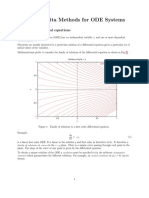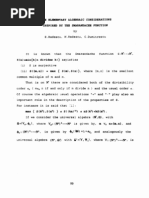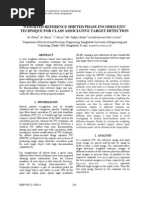17 Electrostatics: 17.1 Potential and Field
17 Electrostatics: 17.1 Potential and Field
Uploaded by
Luis Vargas SanchezCopyright:
Available Formats
17 Electrostatics: 17.1 Potential and Field
17 Electrostatics: 17.1 Potential and Field
Uploaded by
Luis Vargas SanchezOriginal Description:
Original Title
Copyright
Available Formats
Share this document
Did you find this document useful?
Is this content inappropriate?
Copyright:
Available Formats
17 Electrostatics: 17.1 Potential and Field
17 Electrostatics: 17.1 Potential and Field
Uploaded by
Luis Vargas SanchezCopyright:
Available Formats
17
Electrostatics
Electostatics is the study of time-independent distributions of electric charges.
17.1 Potential and Field
Given a spatial distribution of electric charge /)(x,i/,z), the laws of electrostatics make it possible to calculate the electric potential V{x,y,z) and the
electric field E(x,2/, z). These physical quantities are given by
V{x,y,z)
= ^
^TTJ
[ [ [ ,
P(^^y^^O
J J 7 ( x - x^y + {y- y'Y + (z - z'Y
^dx'dy'dz',
E(x,2/,z) = -VF(x,2/,2:),
'dV{x,y,z)
dx
dV{x,y,z)
dy
dV{x,y,z)
dz
17.1.1 Useful Packages
The commands in the package G r a p h i c s ' P l o t F i e l d ' can be used to draw
arrows representing vectors, the direction of the arrow indicating the direction
of the vector field at its base point, and its magnitude being proportional to the
magnitude of the vector field. The package Calculus 'Vector A n a l y s i s ' offers
a variety of tools for doing calculus in various three-dimensional coordinate
systems.
Graphics' PlotField'
Cal cuius 'Vector Analysis'
328
17 Electrostatics
As usual, we can obtain the list of all commands provided by these packages
entering
?Graphics'PlotField'*
and
?Calculus'VectorAnalysis'*
17.1.2 Point C h a r g e
The electric potential at point {x,y,z)
(^o,2/o,^o) is given by
created by a point charge located at
monopolePotential[charge., {xO_, yO_, zO_}, {x_, y_, z_}] :=
charge / (4 Pi S q r t [ ( x - x0)^2 + (y - y0)^2 + (z - z0)^2])
The potential and the field at (x, y, z) created by a point charge q located at
(^o,2/o,^o) = (0,0,0) are
monopolePotentialCq, {0, 0, 0 } , {x, y, z}]
4 Pi Sqrt[x'^ + x'^+x'^]
monopoleField = - Grad[monopolePotentialCq, {0, 0, 0},
{x, y, z}], CartesianEx, y, z]]
q X
qy
'4 Pi (x2+y2 +2^)3/2' 4 Pi (x2 + y 2 ^ 22)3/2'
q z
>!
4 Pi (x^+y^+z^)^/^^
The potential and the field in the plane z = 0 are represented below. We
take zo 7^ 0 to avoid having an infinite expression at the origin (see below:
electricField).
imitMonopoleV[x_, y_] := monopolePotential[l, {O, 0, 0 } ,
{x, y, 0.01}]
17.1 Potential and Field
329
unitMonopoleVEx, y]
2 +
_^ y^]
2i
4 Pi Sqrt [0.0001 -f x^
equiPotentials = ContourPlot[unitMonopoleVEx, y ] ,
{x, - 2, 2}, {y, - 2, 2}, PlotPoints -^ 60,
ColorFunction -^ Hue, ContourSmoothing True];
Fig. 17.1. Equipotentials, in the plane z = 0.01, of a unit electric charge located
at the origin.
The option Contour Smoothing specifies what smoothing to use for contour
lines.
imitCharge = {{RGBColor [1, 1, 0 ] , AbsolutePointSize [ 2 0 ] ,
Point [ {0, 0 } ] } , { T e x t [ ^ ' + 1 ' \ {0, 0}]}};
In the following command, using the option ScaleFunction -^ (1&), all arrows have the same unit length.
e l e c t r i c F i e l d = PlotGradientField[- imitMonopoleV[x, y] ,
{x, - 1, 1}, {y, - 1, 1}, ScaleFunction -^ (1&),
Epilog -^ unitCharge];
330
17 Electrostatics
V
>
>
^
'
'
'
^
> > > > ^
^ > > > ^
/
'
/
^
^
/
/
^
<
^
/ ^
/ <
^^ <
< <
^ ^
+1
- ^ > > ^
^ ^ ^ ^ ^
\ ^
A
*^
^ ^ ^ ^ ^
Fig. 17.2. Electric field created by a unit electric charge located at the origin.
17.1.3 Dipole
The following function gives the electric potential of a dipole (p, 0,0) localized
at the origin and directed along the x-axis.
dipolePotential[p_, {x_, y_, 2 -}] : =
Limit[(monopolePotential[p / a, {a / 2, 0, 0}. {x. y. z}]
- monopolePotential[p / a, {- a / 2 ,0, 0}. {x. y. z}]).
a -> 0]
unitDipoleV[x_, y_] := d i p o l e P o t e n t i a l [ l , {x, y, 0.01}]
We load the package Graphics'Arrow' to be able to use the command Arrow
to draw arrows.
Graphics' Arrow'
unitDipole = Arrow[{0. 1, 0}, {- 0.1, 0},
HeadScaling -> Absolute];
PlotGradientField[unitDipoleV[x,y], {x, - 1, 1}, {y,
ScaleFunction -> (1&), Epilog -> unitDipole];
1, 1},
17.1 Potential and Field
i
^
V
>
>^
*" ^
*" ^
^ 1
^T
. w
'
'
'
^
331
'
'
'
'
^ > > > ^
^
< ^
^
>* ^ ^
1
^
>
^ ^ i
Fig. 17.3. Electric field created by a unit dipole, represented by a bigger arrow,
located at the origin.
The option HeadScaling -^ Absolute makes the head of the arrow, representing the dipole, slightly bigger (see Figure 17.3).
17.1.4 Quadrupoles
We consider different functions that give the electric potential of three or four
electric charges whose sum is equal to zero. In the next section we define a
function to plot the corresponding equipotentials and field lines.
We first define the command q u a d r u p o l e P o t e n t i a l l generating the electric
potential created by three charges 2q,q,q localized, respectively, at
(0,0,0), ( | , 0 , 0 ) , and
(-f,0,o).
quadrupolePotentiall =
monopolePotential[2 q, {0, 0, 0}. {x. y. z}] monopolePotentialCq, {aL / 2 . 0, 0 } . {K. y , z}] monopolePotentialEq, {- a / 2 . 0. 0}. {x, y .z}]
2 Pi Sqrt[x2 + y^ + z^]
4 Pi Sqrt[( + x)^ + y^ + z^]
332
17 Electrostatics
q
4 Pi S q r t [ ( | + x ) 2 + y ^ + z^]
Here is another command giving the electric potential created by four charges
Q^ -Q^ Q^ -Q localized, respectively, at (a/2, a/2,0), (a/2, - a / 2 , 0 ) , (-a/2, - a / 2 , 0 ) ,
and (a/2,a/2,0).
quadrupolePotential2 =
monopolePotential[q, {a / 2, a
monopolePotential[q, {a / 2, monopolePotential[q, {- a / 2,
monopolePotential[q, {- a / 2,
/ 2, 0}, {x, y. z}] a / 2, 0}, {x.y. z}] +
- a / 2, 0}, {j
'-, y, z}] a / 2, 0}, {x.y. z}]
4 Pi S q r t [ ( ^ + x)2 + ( ^ + y)^ + z^]
q
4 Pi Sqrt[(| + x)2 + ( ^ + y)^ + z^]
""
4 Pi S q r t [ ( ^ + x)2 + ( | + y)2 + ^2]
q
4 P i S q r t [ ( ^ + x ) 2 + ( ^ + y ) 2 + z2]
We again consider the electric potential created by three charges 2g, q, q
but localized, respectively, at
(0,0.0), (2,40) and (-1,40).
Their electric potential is given by
quadrupolePotentialS =
monopolePotential[2 q, {0, 0, 0}, {x. y. z}] monopolePotential[q, {aL / 2 , - a / 2, 0}, {x. y z}] monopolePotential[q, {- a / 2> "*a / 2, 0}, {x.y. z}]
2 Pi Sqrt[x2 + y2 + z2]
4 pi S q r t [ ( ^ + x)2 + ( | + y)2 + z2]
17.1 Potential and Field
333
4 Pi S q r t [ ( - + x ) ^ + ( - + y ) 2 + z2]
17.1.5 Plots
W e define the function equipotentialFieldPlot that plots (in the xOyplane) the equipotentials and thefield,and we use it to plot the equipotentials
and the electricfieldlines of the quadrupoles defined above. optionList
stands for zero or more options.
equipotentialFieldPlot[potential-, xRange_, yRange_,
optionList
] :=
Module[{equiPotentials, fieldLines},
equiPotentials = CentourPlot[potential, xRange, yRange,
ContourShading -^ False, ContourSmoothing True,
PlotPoints -^ 60, DisplayFunction -^ Identity];
fieldLines = PlotGradientField[- potential, xRange, yRange,
ScaleFunction -^ (1 & ) , DisplayFimction -> Identity];
Show[{equiPotentials, fieldLines}, optionList,
DisplayFunction -^ $DisplayFunction]];
equipotentialFieldPlot[quadrupolePotentiall /.
{q ^
l,a -> 1, z ^
0.001}, {x, - 2, 2}, {y, - 2, 2},
Epilog -^ {{RGBColor[l, 1, 0 ] , AbsolutePointSize[20],
Point[{0, 0}]}, {RGBColor[l, 1, 0 ] , AbsolutePointSize[20],
Point[{0.5, 0}]}, {RGBColor[l, 1, 0 ] ,
AbsolutePointSize[20], Point[{-0.5, 0}]},
{Text[''+ 2'', {0, 0}], Text[''-1'', {0.5, 0}],
Text[''-1'', {-0.5, 0}]}}];
334
17 Electrostatics
Fig. 17.4. Equipotentials and electric field lines created by three charges respectively
equal to +2 localized at the origin and 1 localized on the Ox-axis at a distance 1/2
and 1/2 from the origin.
equipotentialFieldPlot[quadrupolePotential2
{q ^
l,a -^ 1, z ^
/.
0.001}, {x, - 2, 2}, {y, - 2, 2},
Epilog -^ {{RGBColor[l,l,0], AbsolutePointSize[20],
Point[{0.5, 0.5}]}, {RGBColor[l, 1, 0 ] ,
AbsolutePointSize[20], Point[{0.5, - 0.5}]},
{RGBColor[l, 1, 0 ] , AbsolutePointSize[20],
Point[{- 0.5, - 0.5}]}, {RGBColor[1,1,0],
AbsolutePointSize[20], Point[{- 0.5, 0.5}]},
{Text[''+1'\ {0.5, 0.5}], Text[''-1'\ {0.5, - 0.5}],
Text[''+1'', {- 0.5, - 0.5}], Text[''-1'', {- 0.5, 0.5}]}}];
17.1 Potential and Field
-2
335
-1
Fig. 17.5. Equipotentials and electric field lines created by four charges respectively
equal to 1, + 1 , 1 and + 1 localized at the vertices of a unit square centered at the
origin.
equipotentialFieldPlot[quadrupolePotentialS /.
{q -> l,a -> 1, z ^ 0.001}, {x, - 2, 2}, {y, - 2, 2},
Epilog -^ {{RGBColorEl, 1, 0 ] , AbsolutePointSize[20],
Point[{0, 0}]}, {RGBColorEl,1,0], AbsolutePointSize[20],
Point[{0.5, - 0.5}]}, {RGBColor[l, 1, 0 ] ,
AbsolutePointSize[20], Point[{- 0.5, - 0.5}]},
{Text[''+2'', {0, 0}], Text[''-1", {0.5, - 0.5}],
Text[''-r', {- 0.5, - 0.5}]}}];
Output represented in Figure 17.6.
17.1.6 Uniformly Charged Sphere
Let R be t h e radius of a uniformly charged sphere whose center coincides with
the origin , and let p be the charge density. Spherical symmetry implies t h a t
the electric field is radial and depends only upon t h e distance r to the origin.
This field is easily determined using Gauss law.
336
17 Electrostatics
2
--.XN ^ '
/ ^''x
X' - j-.-_
If/
+2
"M
1
M
T^
1
^
1
k
Fig. 17.6. Equipotentials and electric field lines created by three charges respectively equal to +2 localized at the origin and two negative unit charges localized at
(-1/2,-1/2,0) anc? (1/2,-1/2,0).
eqn = {4 Pi r^2 internalElectricField == 4 Pi r^3 rho
/ 3, 4 Pi r^2 externalElectricField == 4 Pi R'^3 rho /
3}; sol = Flatten[Solve[eqn, {internalElectricField,
externalElectricField}] ]
{internalElectricField
r rho
externalElectricField
R^ rho^
Clear[electricField]
e l e c t r i c F i e l d [ r _ ] := If [r < R, r rho / 3 , R'^3 rho / (3 r'^2)]
plE = P l o t [ e l e c t r i c F i e l d [ r ] / . {R -^ l , r h o -^ 1}, {r, 0, 5 } ,
P l o t S t y l e -^ {RGBColor[0,0,l]}, DisplayFunction -> I d e n t i t y ] ;
17.1 Potential and Field
337
tl = Graphics [Text C inside'\ {0.5, 0.33}]];
t2 = Graphics[Text[''outside'', {3, 0.33}]];
rl = Graphics[{RGBColor[0.5, 0.4, 0 ] ,
Rectangle[{0, 0}, {1, 0.36}]}];
r2 = Graphics[{RGBColor[0.8, 0.8, 0 ] ,
Rectangle[{1, 0}, {5, 0.36}]}];
Show[{rl, r2, plE, tl, t2}, Axes -^ False, Frame -^ True,
TextStyle -^ {FontSlant -^ ''Italic", FontSize -^ 12},
FrameLabel -> {"r'', "E(r)''}, RotateLabel -^ False,
FrameTicks -^ {{0, 1, 2, 3, 4, 5}, {0. 05, 0.15, 0.25, 0.35},
{} {}} Display-Function > $DisplayFunction] ;
0,35
0,25
E(r)
0,15
0,05
Fig. 17.7. Electric field created by a uniformly charged sphere as a function of the
distance r from the sphere center.
RotateLabel specifies whether labels on vertical frame axes should be rotated
to be vertical.
The order of the graphics objects in Show is important, The order {plE, t l ,
t 2 , r l , r2} would mask the plot and the text. The list of graphics objects
has to start with the colored rectangles.
The electric potential can be derived integrating the radial electric field component.
338
17 Electrostatics
externalElectricPotential[r_] = - Integrate[R"3 rho /(3 r"2),
r]
R^ rho
3 r
internalElectricPotential[r_] = externalElectricPotential[R]
Integrate[r rho / 3, {r, R, r}] // Simplify
- ( r 2 - 3 R^) rho
Clear[electricPotential]
electricPotential[r_] := If [r < R, - (r^2 - 3 R'^2) rho / 6,
R'^3 rho / (3 r)]
plV = Plot[electricPotential[r] /. {R -> l,rho -^ 1}, {r, 0,
5},
PlotStyle -^ {RGBColor[0,0,1]}, DisplayFunction -^ Identity]
tl = Graphics[Text[''inside'\ {0.5, 0.3}]];
t2 = Graphics[Text[''outside'^ {3, 0.3}]];
rl = Graphics[{RGBColor[0.4, 0.4, 0 ] ,
Rectangle[{0, 0}, {1, 0. 5}]}];
r2 = Graphics[{RGBColor[0.8, 0.8, 0 ] ,
Rectangle[{1, 0}, {5, 0.5}]}];
Show[{rl, r2, plV, tl, t2}. Axes -^ False, Frame -> True,
TextStyle -^ {FontSlant -^ ''Italic'', FontSize -^ 12},
FrameLabel -^ {''r", " V ( r ) " } , RotateLabel -> False,
DisplayFunction -^ $DisplayFunction];
17.1 Potential and Field
339
0.5
0.4
0.3
V{r)
0.2
0.1
3
r
F i g . 17.8. Electric potential created by a uniformly charged sphere as a function of
the distance r from the sphere center.
You might also like
- Zibro Service ManualDocument85 pagesZibro Service Manualmorphelya100% (3)
- Harmonic_PotentialsDocument13 pagesHarmonic_Potentialsopwatson55No ratings yet
- Mat1503 A05Document29 pagesMat1503 A05Duncan Jäger DMninetynineNo ratings yet
- Cherednik-1995-Double Affine Hecke Algebras and Macdonald's ConjecturesDocument26 pagesCherednik-1995-Double Affine Hecke Algebras and Macdonald's ConjectureslucassecoNo ratings yet
- MATLAB code Week 10 and 11Document13 pagesMATLAB code Week 10 and 11joonramparkash1974No ratings yet
- Profit Functions: Epresentation of EchnologyDocument34 pagesProfit Functions: Epresentation of EchnologyxcscscscscscscsNo ratings yet
- Experiment 10Document9 pagesExperiment 10WAQAR BHATTINo ratings yet
- Optical TheoremDocument5 pagesOptical TheoremMario PetričevićNo ratings yet
- 9.triple Integrals - MatlabDocument9 pages9.triple Integrals - Matlabsamspamz946No ratings yet
- MathSlov 50-2000-2 5Document10 pagesMathSlov 50-2000-2 5mirceamercaNo ratings yet
- Sin (1/x), Fplot Command - y Sin (X), Area (X, Sin (X) ) - y Exp (-X. X), Barh (X, Exp (-X. X) )Document26 pagesSin (1/x), Fplot Command - y Sin (X), Area (X, Sin (X) ) - y Exp (-X. X), Barh (X, Exp (-X. X) )ayman hammadNo ratings yet
- Chapter 02Document12 pagesChapter 02blooms93No ratings yet
- CEM Lab 4 - MergedDocument10 pagesCEM Lab 4 - MergedShrie VarshiniNo ratings yet
- Math BookDocument160 pagesMath BookDonovan WrightNo ratings yet
- Lattice Dynamics HW2Document7 pagesLattice Dynamics HW2Praveen kumar yadavNo ratings yet
- Numerical Solution of Laplace Equation Using Method of RelaxationDocument7 pagesNumerical Solution of Laplace Equation Using Method of Relaxationsthitadhi91No ratings yet
- 1.3 Functions and Their GraphsDocument0 pages1.3 Functions and Their GraphsJagathisswary SatthiNo ratings yet
- DifferentialDocument8 pagesDifferentiali227438No ratings yet
- DerivativesDocument2 pagesDerivativesHarold BalubalNo ratings yet
- Python MAC-4Document25 pagesPython MAC-4spandymandal05No ratings yet
- 4curve Fitting TechniquesDocument32 pages4curve Fitting TechniquesSubhankarGangulyNo ratings yet
- Robotics Lab Lecture #5: Purpose of This LectureDocument5 pagesRobotics Lab Lecture #5: Purpose of This LectureSonosoNo ratings yet
- Runge-Kutta Methods For ODE Systems: Ordinary Differential EquationsDocument8 pagesRunge-Kutta Methods For ODE Systems: Ordinary Differential EquationsEmir NezirićNo ratings yet
- Maths Lab Manual 22mats11Document37 pagesMaths Lab Manual 22mats11ANU100% (1)
- Solving Poisson's Equation by Finite DifferencesDocument6 pagesSolving Poisson's Equation by Finite DifferencesEugene LiNo ratings yet
- Silicio Phonon DispersionDocument6 pagesSilicio Phonon DispersionMoises Vazquez SamchezNo ratings yet
- ElectromagneticsDocument10 pagesElectromagneticsLencie Dela CruzNo ratings yet
- Fundamentals of Ultrasonic Phased Arrays - 201-210Document10 pagesFundamentals of Ultrasonic Phased Arrays - 201-210Kevin HuangNo ratings yet
- Maxima Minima 3DDocument5 pagesMaxima Minima 3Dzubinp2202No ratings yet
- Emfesoln chp08 PDFDocument26 pagesEmfesoln chp08 PDFvakilgaurangiNo ratings yet
- Chapter 1Document21 pagesChapter 1syazniaizatNo ratings yet
- Chapter 14 - Vector CalculusDocument86 pagesChapter 14 - Vector CalculusRais KohNo ratings yet
- Exp02 516 Field PatternDocument2 pagesExp02 516 Field PatternMd. Omar FarukNo ratings yet
- Chaos in Electronics (Part 2)Document138 pagesChaos in Electronics (Part 2)SnoopyDoopyNo ratings yet
- MTH207 Lab 1 HomeworkDocument4 pagesMTH207 Lab 1 HomeworkCarolyn WangNo ratings yet
- Introduction To MATLAB For Engineers, Third Edition: Numerical Methods For Calculus and Differential EquationsDocument47 pagesIntroduction To MATLAB For Engineers, Third Edition: Numerical Methods For Calculus and Differential EquationsSeyed SadeghNo ratings yet
- NK Emt Practical PDFDocument38 pagesNK Emt Practical PDFshubh soniNo ratings yet
- A1 Priyanshu Dutta MathematicsDocument8 pagesA1 Priyanshu Dutta MathematicspshuNo ratings yet
- Some Elementary Algebraic Considerations Inspired by The Smarandache FunctionDocument5 pagesSome Elementary Algebraic Considerations Inspired by The Smarandache FunctionRyanEliasNo ratings yet
- Line Integral and Greens TheoremDocument7 pagesLine Integral and Greens Theoremmannoj.atheesivam2024No ratings yet
- Weighted Reference Shifted Phase Encoded Fringe Adjusted Joint Transform Correlator For Class Associative Multiple Target DetectionDocument4 pagesWeighted Reference Shifted Phase Encoded Fringe Adjusted Joint Transform Correlator For Class Associative Multiple Target Detectionmunadil98No ratings yet
- Ch02 - Coulomb's Law and Electric Field IntensityDocument26 pagesCh02 - Coulomb's Law and Electric Field Intensityjp ednapilNo ratings yet
- SCILAB Elementary FunctionsDocument25 pagesSCILAB Elementary FunctionsMAnohar KumarNo ratings yet
- Mathcad FunctionsDocument33 pagesMathcad FunctionsAnge Cantor-dela CruzNo ratings yet
- Matlab Code 3Document29 pagesMatlab Code 3kthshlxyzNo ratings yet
- Chapter 13Document55 pagesChapter 13Ahsanul Amin ShantoNo ratings yet
- Tutorial On Gabor Filters: Javier R. MovellanDocument21 pagesTutorial On Gabor Filters: Javier R. MovellanSandip MehtaNo ratings yet
- McQuarrie Chapter 4 ProblemsDocument18 pagesMcQuarrie Chapter 4 ProblemsUpakarasamy LourderajNo ratings yet
- Electromagnetic 2Document8 pagesElectromagnetic 2dinakamelNo ratings yet
- SVM_1997Document11 pagesSVM_1997Roney Das Merces CerqueiraNo ratings yet
- Experiment 3Document16 pagesExperiment 3WAQAR BHATTINo ratings yet
- 2 Scalar and Vector FieldDocument57 pages2 Scalar and Vector FieldVivek Kumar100% (1)
- Calculus of Variation and Image Processing: Scalar ProductDocument9 pagesCalculus of Variation and Image Processing: Scalar ProductAditya TatuNo ratings yet
- Gradient divergence curl (1)Document6 pagesGradient divergence curl (1)joonramparkash1974No ratings yet
- Matlab 02Document6 pagesMatlab 02babelneerav299No ratings yet
- Conformal Field NotesDocument7 pagesConformal Field NotesSrivatsan BalakrishnanNo ratings yet
- Student Solutions Manual to Accompany Economic Dynamics in Discrete Time, second editionFrom EverandStudent Solutions Manual to Accompany Economic Dynamics in Discrete Time, second editionRating: 4.5 out of 5 stars4.5/5 (2)
- Student's Solutions Manual and Supplementary Materials for Econometric Analysis of Cross Section and Panel Data, second editionFrom EverandStudent's Solutions Manual and Supplementary Materials for Econometric Analysis of Cross Section and Panel Data, second editionNo ratings yet
- Philosophy - A School of FreedomDocument303 pagesPhilosophy - A School of Freedomapi-3811062100% (4)
- Effect of Education On HRQoL - EQ5D CutoffDocument9 pagesEffect of Education On HRQoL - EQ5D CutoffTrang HuyenNo ratings yet
- Khalifa Sheikh Ishaka Rabiu College: Endof3 TERM EXAMINATION 2020/2021 Subject:Hausa Class:Primary 2Document24 pagesKhalifa Sheikh Ishaka Rabiu College: Endof3 TERM EXAMINATION 2020/2021 Subject:Hausa Class:Primary 2shahadah connectNo ratings yet
- ArresterWorks Facts-001 Arrester Lead LengthDocument11 pagesArresterWorks Facts-001 Arrester Lead Lengthnshj196No ratings yet
- 9 Science NcertSolutions Chapter 10 ExercisesDocument12 pages9 Science NcertSolutions Chapter 10 Exercisestindutt life timeNo ratings yet
- History of Bellakar: Adapted and Modified From Bellakar (2001) by Eric DubourgDocument11 pagesHistory of Bellakar: Adapted and Modified From Bellakar (2001) by Eric DubourgFabien WeissgerberNo ratings yet
- British Airways EmiratesDocument5 pagesBritish Airways Emiratesmubeen yaminNo ratings yet
- Esab Rustler Mig Compact Instruction ManualDocument44 pagesEsab Rustler Mig Compact Instruction ManualgelsondwalaNo ratings yet
- Finite Element Method Chapter 4 - The DSMDocument17 pagesFinite Element Method Chapter 4 - The DSMsteven_gogNo ratings yet
- Group 1 Assignment-Errors With Parallel Structure and Errors With PronounsDocument5 pagesGroup 1 Assignment-Errors With Parallel Structure and Errors With PronounsAisyah FitriNo ratings yet
- 3 5 1Document268 pages3 5 1rajrudrapaaNo ratings yet
- 4 Way AC Power Change OverDocument1 page4 Way AC Power Change OverHaroon Javed QureshiNo ratings yet
- C MAMI Tool Total C MAMI PackageDocument52 pagesC MAMI Tool Total C MAMI PackageFaruque AhmadNo ratings yet
- Тензодатчик Schenck PWSDocument2 pagesТензодатчик Schenck PWSАнтон ХмараNo ratings yet
- Krasa Vin 2008Document4 pagesKrasa Vin 2008Йоханн БуренковNo ratings yet
- Pale OneDocument1 pagePale Onejoel lealNo ratings yet
- Project Title: The Impact of Power Plant On The Quality of Soil For ConstructionDocument34 pagesProject Title: The Impact of Power Plant On The Quality of Soil For ConstructiondhananjaysinghNo ratings yet
- 08 Quite InformativeDocument2 pages08 Quite InformativeQazi BaranNo ratings yet
- Complete Body Transformation Manual The Ultimate 12 Week Workout Plan Suitable For Women and Men Sean Lerwill PDF For All ChaptersDocument70 pagesComplete Body Transformation Manual The Ultimate 12 Week Workout Plan Suitable For Women and Men Sean Lerwill PDF For All Chapterswiggerannik55100% (12)
- Bani (Body of Knowledge)Document35 pagesBani (Body of Knowledge)aztex styxesNo ratings yet
- The Warping Torsion Bar Model of The Differential Quadrature MethodDocument9 pagesThe Warping Torsion Bar Model of The Differential Quadrature Methodchristos032No ratings yet
- University of Reading, 11KV Cable Trench Whiteknights Campus, ReadingDocument17 pagesUniversity of Reading, 11KV Cable Trench Whiteknights Campus, ReadingWessex ArchaeologyNo ratings yet
- Desiccant Regenerative Dryers: 3-10,000 SCFMDocument12 pagesDesiccant Regenerative Dryers: 3-10,000 SCFMarifNo ratings yet
- Topics NO No of Hours Marks Weightage in ExamDocument8 pagesTopics NO No of Hours Marks Weightage in ExamSaeed cecos1913No ratings yet
- SRM IST, Kattankulathur - 603 203: Sub Code & Name: 18EES102L WORKSHOP LABDocument7 pagesSRM IST, Kattankulathur - 603 203: Sub Code & Name: 18EES102L WORKSHOP LABgautam KrishnaNo ratings yet
- MCN ReviewerDocument10 pagesMCN ReviewergreinabelNo ratings yet
- Eos Full ReportDocument52 pagesEos Full Reportsarath_srkNo ratings yet
- C2 W1 MergedDocument286 pagesC2 W1 Merged1SI20CS076 PRADEEP H VNo ratings yet
- A11122XG W/B Gloss Coating: Technical Data SheetDocument1 pageA11122XG W/B Gloss Coating: Technical Data SheetYenifer LinaresNo ratings yet

























































































